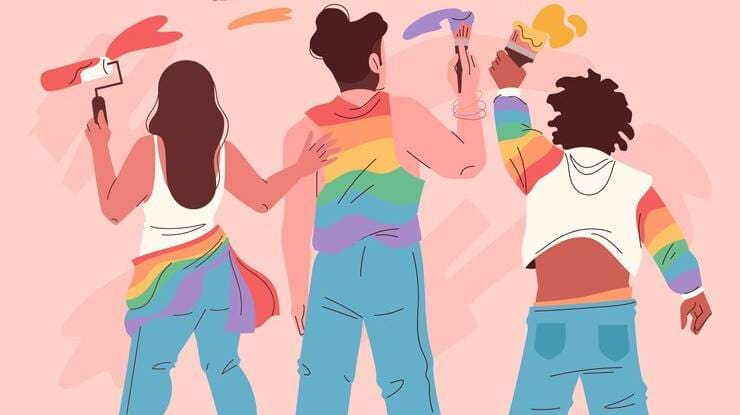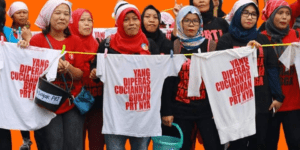Many writers, researchers, activists and artists have researched and created important knowledge bases about the emergence of the she male or transwomen movement in Indonesia.
The emergence of the transwomen or transgender movement in Indonesia then gave rise to a new spirit of optimism in social movements.
Nowadays, some of them are marked by the growth of transwomen organizations, including the emergence of Transschools, Sanggar Seroja, Fajar Sikka community, Inti Muda, Transwomen Islamic Boarding Schools, as well as several other transwomen communities or collectives spread across Indonesia.
This movement advances by introducing the identity of transwomen in advocating discrimination that occurs in their environment. This community-based movement puts forward the struggle for diversity with the uniqueness of transwomen.
Their experiences are dug deeper in this organization, transwomen fraternity is run as a form of togetherness, considering that the average transwoman lives alone and mostly struggles to live without a family.
All these organizations then produce knowledge that I call the various colors of the rainbow, meaning that there is a meaning of the rainbow there that is associated with their souls and lives.
This rainbow organization always gives birth to many fresh ideas, including explaining the pathology of transgender, producing theater videos, and producing writings in the form of anthologies, although all of these are still slowly moving in the shadows. This means that the Indonesian state has not yet fully accepted the identity of transwomen as a new recognized identity, so this organization is still in the shadow of fear.
If we look, although there are different ways of advocating in each of these organizations, what needs to be seen is the impact of the advocacy and the goal of the struggle to free from discrimination, violence and fear.
For example, Sanggar Seroja uses tradition to introduce transwomen’s life through traditional roots through the medium of theater, as well as how they process waste into clothing. This strategy is enough to amaze the public because Sanggar Seroja pays attention to the issue of equality based on the environment.
Then Transschool which makes gender school events and introduces gender diversity and sexuality. The requirements of the selected transwomen also adhere to the diversity of body shapes, hair and expressions of transwomen. This transschool event is a success and has consistently lasted for more than ten years.
Another thing that should be noted in this transwomen struggle is the public’s unintentional acknowledgment of the transwomen language. Why do I call it unintentional, because even though many of them do not recognize transwomen as their identity, transgender language has been widely used en masse.
The history of the transwomen language is well known among the transwomen community itself. Among the figures who contributed to popularizing the transwomen language in Indonesia that I noted, one of them is the late Tata Dado and the late Ade Juwita. They are both lenong rumpi players who triumphed in the 1990s.
This transwomen language, to the best of my knowledge, was originally recorded by Tata Dado. According to sources I know, Tata even always carries a note with him everywhere. The goal is to record any words that can be created for the transwomen language.
In its development, in oppressive power relations, transwomen languages were still allowed to be published, although they had to use a more down-to-earth title. The transwomen language dictionary was later published under the name: slang dictionary. The dictionary was widely circulated among the general public and went into print until the eleventh printing.
Then there are lots of intellectuals and academics making dictionaries, theses and research on this language.
As an Indonesian transwomen, I am proud that there is a slang dictionary that captures various transwomen vocabularies. Therefore, I also have a responsibility to preserve, to bring this language to life. Because this is the legacy of the transwomen speech tradition, I need to re-examine the origin of this language.
The original language of the transwomen group that I know has a unique intonation and when spoken it will have a distinctive tone of kenes. The language was then used in the conversations of transwomen throughout Indonesia.
Words in the transwomen language can end with the suffix ong suffix wati or with the name of a place, and a person’s name is also neologism (new word expression), and shifts in meaning. Examples of words ending with the suffix ong are bencong, sekong, alemong, kemenong, centong examples of words that are inserted with the suffix wati, for example busywati, rumpikwati, which means busy and chatty.
Examples of words in transwomen language utterances that use a shift in meaning such as maharani means expensive, mursida means cheap, and examples of words that use neologism use the word lamberta labambang sidora dori which means very late, airline which means face mask.
In speech, transwomen also often use place names, people’s names and certain brand names, such as brandy bottles, panasonic, motorola which means handsome young men, hot air, and motorized vehicles.
Then there are the names of people such as Kajol, Titi dj, and Machica Mochtar which means the word traffic jam and the words to be careful on the road, not clear or grandpa is ugly, and use place names like soccer field which means hungry.
Not only that, social facilities are also the use of the use of transwomen language. This is evidence of the influence of transwomen people by heteronormative circles, with many members of the general public indirectly using this transgender language.
This language becomes inclusion and makes the transwomen people who experience marginalization visible and readable in the situation.
Without it, all of our society will be cynical if they see Transwomen. The public will understand if various texts containing in-depth introductions to transwomen can be read.
(Translator: Dwi Ayu Trisna Andini)













